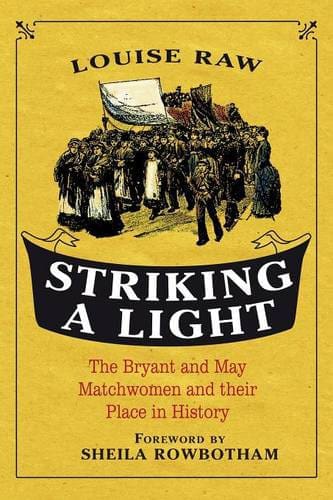The Matchgirls Who Sparked a Revolution
How the Bryant & May Women Changed British Labour
In 1888 London, a group of working-class women at the Bryant & May match factory challenged the injustices of industrial labour and made history. These young women, many barely in their teens, endured long hours, low wages, and life-threatening conditions. Their strike not only improved their workplace but also became a cornerstone in the British labour movement, inspiring future generations of activists.
Today, the story of the Matchgirls’ Strike serves as a powerful reminder of the impact of women-led collective action and the enduring fight for workers’ rights.

“It just went like tinder; one girl began, and the rest said ‘yes’, so out we all went.”
A striking worker
All of our content is free to access. An independent magazine nonetheless requires investment, so if you take value from this article or any others, please consider sharing, subscribing to our mailing list or donating if you can. Your support is always gratefully received and will never be forgotten. To buy us a metaphorical coffee or two, please click this link.
Table of Contents
*All Book Images Open a New tab to our Bookshop
**If you buy books linked to our site, we get 10% commission from Bookshop.org, whose fees support independent bookshops.
The Spark of Defiance: Harsh Conditions at Bryant & May
The Bryant & May match factory, located in Bow, East London, was notorious in the late 19th century for its exploitative and unsafe working conditions, particularly for women and girls. The workforce was overwhelmingly female – often teenagers – many of whom were poor, Irish immigrants seeking employment in the city. While the factory generated enormous profits, these women were subjected to long, gruelling hours, typically 12 to 14 per day, for wages that barely covered their living expenses.
A major source of resentment was the fine system, designed to punish workers for minor infractions. Women could be fined for things as trivial as untidy workbenches, being late, talking while working, or even having dirty feet. These fines often consumed a significant portion of their already low wages, leaving many struggling to survive. This system of constant surveillance and penalties fostered fear and stress, yet the women endured it silently – until their courage ignited a strike.

Beyond the financial exploitation, the physical dangers of the work were extreme. Matches at the time were made with white phosphorus, a toxic substance that caused “phossy jaw,” a painful and disfiguring disease where the jawbone would rot, sometimes leading to death. Despite public awareness of its devastating effects, Bryant & May continued using white phosphorus because it was cheap and effective for mass production. The women risked not only immediate injury but long-term health consequences, a daily reminder of the imbalance between profit and human life.
Amid these harsh conditions, the workers began to develop awareness and solidarity. Social reformers like Annie Besant exposed the factory’s abuses in publications such as The Link, but it was the women themselves who organized, planned, and executed the strike. Their knowledge of the system, combined with collective courage, transformed personal suffering into organized resistance, sparking one of the most significant labour actions of the era.
“Women, like men, should try to do the impossible. And when they fail, their failure should be a challenge to others.”
Annie Besant
The Strike: Courage, Solidarity, and Action
The Bryant & May Matchgirls’ Strike of 1888 was a remarkable example of courage and collective action, especially given the social and economic context of the time. These women and girls, many just in their teens, risked losing their jobs, livelihoods, and even housing by challenging one of London’s largest industrial employers. Yet, on July 5, 1888, they walked out, demanding fair wages, an end to the oppressive fines system, and safer working conditions. Their action was spontaneous but coordinated, fuelled by a shared sense of injustice and a desire for dignity.
What made the strike particularly powerful was the solidarity among the workers. The matchgirls supported one another morally and financially, pooling small contributions to help those who had no wages while the strike continued. This sense of unity allowed them to sustain pressure on Bryant & May for several weeks. One striking worker recalled the moment the walkout began: “It just went like tinder; one girl began, and the rest said ‘yes’, so out we all went.”
This statement encapsulates both the spontaneity and the deep-rooted shared determination among the women. Their strike was not merely a protest – it was a collective assertion of agency, challenging societal expectations that young, working-class women should remain silent in the face of exploitation.
The strike also drew significant public attention. Social reformers, journalists, and concerned citizens rallied behind the matchgirls, amplifying their demands and shaming the company into action. Contemporary observers noted the striking girls’ steadfast determination: “Few people could fail to be touched by the way in which the girls were determined to stand together at all costs.”
This solidarity was not only internal; it inspired other workers across London. The success of the matchgirls demonstrated that organized, collective action could achieve tangible results, paving the way for the New Unionism movement, which emphasized organizing unskilled and marginalized workers – including women – for broader labour reforms.
Ultimately, the strike was a landmark moment in British labour history. It highlighted the power of courage, unity, and strategic action, proving that even the most vulnerable workers could demand change. The matchgirls’ strike showed that standing together – despite fear, societal pressures, and economic vulnerability – could secure justice and dignity in the workplace, leaving a lasting legacy for future generations of labour activists.

Victory and Recognition: A Historic Milestone
The culmination of the Bryant & May Matchgirls’ Strike in 1888 was nothing short of historic. After several weeks of persistent protest, the company finally conceded to the workers’ demands, abolishing the exploitative fines system and improving wages and working conditions. For a workforce largely composed of young, working-class women, this was an extraordinary triumph. Their victory was not only material – it was a moral and symbolic win, showing that ordinary women could successfully confront powerful industrial employers.
The significance of the strike extended far beyond the factory gates. The matchgirls’ actions sent a clear message to employers and policymakers alike: organized collective action could lead to real change, even for workers who were previously considered powerless. Their courage and solidarity inspired other labour movements across London and the United Kingdom, demonstrating that strikes could be both peaceful and effective. The success of the matchgirls helped fuel a wave of New Unionism, a movement aimed at organizing unskilled workers and women into trade unions, broadening the labour movement beyond traditional male-dominated unions.
Even Journalists Highlighted the Matchgirls’ Resilience
The strike also earned recognition from influential figures in the labour and political spheres. Trade union leaders, social reformers, and even journalists highlighted the matchgirls’ resilience, framing their story as a paradigm of worker empowerment. John Burns, a prominent labour activist, reflected on the broader impact: “The matchgirls had formed a union and had got what they wanted, and surely the Dock Labourers could do the same.”
This acknowledgment underscored how the matchgirls’ success inspired confidence in collective bargaining among other groups of workers, reinforcing the idea that solidarity and organization could overcome exploitation.
Ultimately, the strike’s legacy lies not just in the immediate gains for the matchgirls themselves, but in its lasting influence on labour relations in Britain. It demonstrated that courage, unity, and strategic action could challenge injustice, setting a precedent for future generations of women and men in the fight for workers’ rights, dignity, and fair treatment. The Bryant & May strike remains a milestone in the history of labour activism, showing how even the most marginalized workers can become powerful agents of change.

Legacy: How the Matchgirls Shaped Labour Rights
The impact of the Bryant & May Matchgirls’ Strike went far beyond the immediate improvements in wages and working conditions. By standing up to one of London’s largest employers, these young women fundamentally challenged assumptions about who could be a worker with agency and who could influence the course of labour history. At a time when trade unions were largely male-dominated and often excluded unskilled or female workers, the matchgirls’ strike demonstrated that even the most marginalized could organize and achieve tangible results
Their success helped lay the foundation for New Unionism, a movement that emerged in the late 19th century with a focus on organizing unskilled labourers, women, and other previously overlooked workers. Unlike earlier unions, which primarily represented skilled male tradesmen, the new wave emphasized inclusive, grassroots organization, with collective action as a means to secure fair treatment. The matchgirls became a model for this approach, showing that solidarity, strategic coordination, and moral courage could shift power dynamics in the workplace.
“The matchgirls had formed a union and had got what they wanted, and surely the Dock Labourers could do the same.”
John Burns
The Broader Cultural and Political Conversation Around Workers’ Rights
Moreover, the strike influenced the broader cultural and political conversation around workers’ rights, labour laws, and industrial safety. It drew attention to the exploitation of women and children in factories, the dangers of hazardous substances like white phosphorus, and the injustices of punitive wage systems. Their actions helped pave the way for legislative reforms, such as the eventual banning of white phosphorus in match production in the early 20th century, and inspired campaigns for safer working conditions across multiple industries.
The legacy of the matchgirls is also symbolic. They challenged societal expectations of women as passive or subordinate, showing that collective action and courage could redefine gender roles within the labour movement. Their story continues to inspire activists, labour organizers, and feminists alike, serving as a reminder that meaningful change often begins with ordinary people daring to stand together against injustice.
In short, the Bryant & May women did more than improve their own working conditions – they reshaped the trajectory of labour activism in Britain, expanded the possibilities of union organization, and became enduring icons of resilience, solidarity, and social justice. Their impact resonates in labour rights movements to this day.
Lessons from the Matchgirls
The story of the Bryant & May Matchwomen is far more than a historical anecdote – it is a blueprint for courage, solidarity, and social change. Their strike in 1888 demonstrated that even the most marginalized and vulnerable workers could challenge powerful employers and achieve meaningful reform. By walking out of the factory and demanding fair treatment, they proved that collective action and unwavering determination can overcome entrenched systems of exploitation.
One of the most enduring lessons from the matchgirls is the power of solidarity. Despite their youth, limited resources, and social vulnerabilities, these women supported one another morally and financially throughout the strike. This unity allowed them to sustain pressure on Bryant & May, forcing the company to concede to their demands. Their example shows that shared purpose and mutual support are essential components of successful activism, particularly when facing formidable opposition.

“Few people could fail to be touched by the way in which the girls were determined to stand together at all costs.”
Toilers in London
Leaders in a Movement that had Long Excluded Them
The matchgirls also reshaped societal perceptions of women in the workplace. At a time when female labourers were often overlooked and undervalued, these young women asserted their agency, challenged stereotypes, and became leaders in a movement that had long excluded them. Their courage inspired other labour actions, contributed to the growth of inclusive trade unions, and helped pave the way for legislative reforms addressing workplace safety and labour rights.
Ordinary People, When United, Can Spark Extraordinary Change
Finally, the legacy of the Bryant & May Matchwomen is timeless. Their strike underscores the importance of speaking out against injustice, no matter how overwhelming the odds may seem. It reminds us that ordinary people, when united, can spark extraordinary change. For modern labour movements, feminist activism, and social justice campaigns, their story is both a guide and an inspiration – proof that resilience, courage, and solidarity can leave a lasting mark on society.











































Leave a Comment